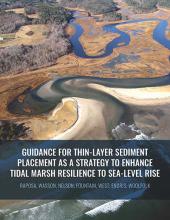
Tidal marshes provide key ecosystem services, but they are threatened by sea level rise. For these ecosystems to survive, it will require active management to increase tidal marsh resilience. Thin-layer placement (TLP), an emergent adaptation strategy that mimics natural sediment deposition processes, is one of the only viable options to protect tidal marshes in their current footprint. To improve the success of thin-layer placement projects, a collaborative research team at the Narragansett Bay and Elkhorn Slough National Estuarine Research Reserves led coordinated restoration experiments at eight Reserves on the US East and West coasts to test TLP across diverse marsh plant communities, and produced guidance and recommendations for TLP use.
About this resource
This guidance document discusses the potential benefits and tradeoffs involved in thin-layer sediment placement for tidal marsh resilience in the United States. It is intended to help restoration practitioners, property owners, coastal managers, and funders better understand this strategy for tidal marsh restoration and resilience in the face of sea level rise. It offers the following resources and tools to assess and undertake TLP projects:
- Consensus statement on thin-layer sediment placement in tidal marsh ecosystems that summarizes the state of knowledge about TLP, calls for further restoration research to test its effectiveness, and makes recommendations for its use.
- Literature review of TLP science and practice for tidal marsh resilience in the United States.
- Monitoring guidelines with universal metrics for restoration success, for use with TLP projects in diverse types of tidal marshes and geographies.
- Permitting memo with a step-by-step guide to navigate the permitting process for TLP projects.
Raposa, K., K. Wasson, J. Nelson, M. Fountain, J. West, C. Endris, and A. Woolfolk. 2020. “Guidance for Thin-Layer Sediment Placement as a Strategy to Enhance Tidal Marsh Resilience to Sea-Level Rise. ” Published in collaboration with the National Estuarine Research Reserve System Science Collaborative.